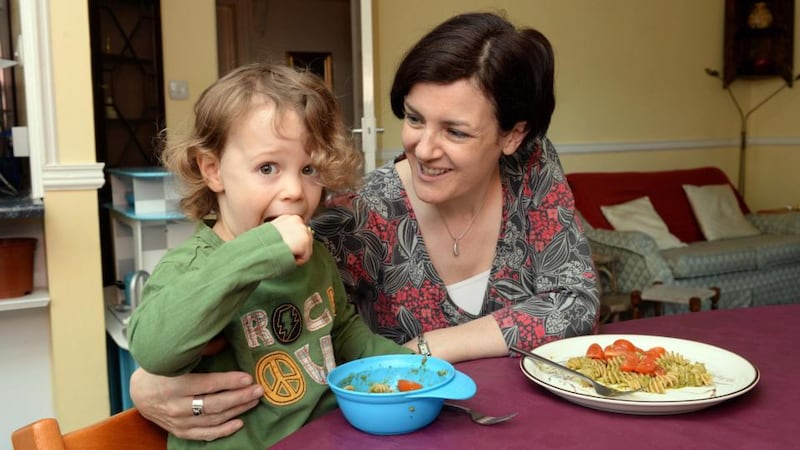Do you nibble food from your children’s plates? Eat toast on the run in the morning? Devour biscuits with a cup of tea in front of the television in the evening? Munch your way through popcorn at the cinema?
It’s the sort of mindless eating that we all do, on auto-pilot, whether we’re hungry or not. For me, the sight of an empty screen is enough to trigger it. Reaching for another cup of coffee or a snack is a knee-jerk reaction to wrestling with the opening sentence of an article – in consolation or in the hope of inspiration I’m not sure.
Or maybe it is just displacement activity, to delay the task at hand. One thing is sure, I’m thinking about what I’m writing, not what I’m eating when I’m doing it.

“Mindful eating” is the very opposite. The idea is to think of nothing but what you’re eating.
It’s the application of the increasingly popular practice of mindfulness – being “in the moment” – to a specific part of your life. And even if meditation is not for you, there are elements of mindful eating that will help any family adopt a healthier lifestyle.
Stomaching the figures
In our "obesogenic" western world – where food is available at every turn and a sedentary lifestyle the norm – there is a disconnect between hunger and eating, as well as a gulf between the sort of food being consumed and the nutrition the body needs.
About one in four primary school children here is now either overweight or obese, while two-thirds of adults fall into that category.
The extent of what’s a complex problem is obvious, the solution is not. Restricted diets clearly don’t work for most people in the long term – mainly because they are “imposed” and there’s too much deprivation involved to make the weight loss sustainable.
Proponents of mindful eating offer a different tack. The theory is that by listening to your body more, better food choices will follow.
Changing habits is never easy but recognising them for what they are is a start.
A mindful eating programme was shown to be significantly more effective than just giving out diet and exercise information in a study of obese teenage girls in the US, a recent conference at the Royal College of Surgeons in Ireland (RCSI) heard.
Over the six weeks of the programme, the girls aged 14-17, with an average weight of 90kg (14 stone), lost an average of 2.38kg (5.25lb) each, whereas the comparison group gained an average of 1.81kg (4lb) in that time.
Types of hunger
The weekly, after-school sessions on mindful eating focused on seven different types of hunger, encouraging the teenagers to look at what stimulated them to eat. Meanwhile, those in the comparison group were given a healthy living guide covering nutrition and exercise, as well as weekly emailed tips.
Although a sense of solidarity in the sessions could be expected to have an impact, the body mass index (BMI) of the mindful eating participants continued to decline for the four weeks after the end of the programme, until the completion of the study at 10 weeks.
This suggests that it was learning mindful eating skills which led to the lowering of the BMI, rather than the group support, says the study’s author, Patricia Daly of the University of Arizona College of Nursing, who presented her findings to the RCSI’s Faculty of Nursing and Midwifery Conference in Dublin last month.
"Simply put, mindful eating is 'channelling your inner two year old', knowing when you are full and refusing to continue to eat," Daly tells The Irish Times .
As well as looking at different cues for eating, the teenagers practised eating mindfully on the course, she explains. “Practising a specific behavioural skill facilitates change in health behaviour.”
Remarkable result
Two students who fully grasped the concept lost a "remarkable" amount of weight, she reports – one 10.4kg (23lb) and the other 13.6kg (30lb) after 10 weeks.
And Daly has no doubt that such a mindful eating programme is a feasible and effective tool in combating obesity among teenagers.
Typically, adolescents are submerged in the fast food culture. It’s a time of spontaneity, increasing independence and rebellion against the “rules” of childhood.
“Paediatric obesity has doubled in the US over the past three decades,” says Daly. “The most affected subgroup is adolescents, and their rate of obesity has tripled.” Some 80 per cent of obese teenagers go on to be obese adults.
What advice does she have for parents in implementing elements of mindful eating into family life?
“Along with making nutritious choices, check in with your body and learn to notice when you are full,” she replies. “Never force a child to eat when they are not hungry. Do not eat because you are lonely, tired, angry or bored.”
As in all aspects of parenting, it is what you do rather than what you say that counts. Lead by example and ensure your family eats together around one table whenever possible – a tradition that is lost to some in the hectic comings and goings of modern life.
Mindful eating specialist Gráinne-Freya Hammond would encourage parents to get up 10 minutes earlier if that’s what it takes to be able to sit and have breakfast with your children before everybody heads their separate ways. Ideally, you are reunited over the dinner table in the evening. It is not always easy but is very worthwhile to make the effort to sit together, she says. “It has a huge effect on the dynamic and the health of the family, as well as food habits.”
Mindful eating has a big effect on the digestive system, explains Hammond, a homeopath who lives in Loughrea, Co Galway and runs a health consultancy called The Dynamic Turnaround.
“If you eat in front of the television, you are distracted. The body puts the energy somewhere else instead of digesting the food.”
Focus on eating
US research has shown that when our attention is not focused on eating, our digestive process is up to 30-40 per cent less effective, which can cause gas, bloating and discomfort.
Fidelma Farley has been teaching mindfulness for six years and came across mindful eating when doing a further course about mindfulness for teenagers.
She found it really interesting, not only professionally but also personally, as somebody who has been a lifelong comfort eater and suffers digestive problems.
“There are so many emotions around eating for most of us – comfort, reward, celebration. To me that has been the most interesting area, untangling that.”
A key element is looking at your eating patterns without judgment.
“That really makes a big difference – you are looking at something, not to condemn it but just to see what is actually going on,” she says. “That makes it a lot easier to take on board and change it, if you need to and want to.”
It is all about “really listening to your own body and that takes time and effort”. Start with simple steps, such as pausing before a meal.
“If you’re sitting down a bit stressed, the chances are that you will eat quickly and when we eat quickly we tend to eat more than we need,” she points out.
But if you pause long enough to realise that you are stressed and need to slow down, “the chances are that you will eat more slowly, which we all know is better for our digestion”.
Gauging your hunger level is also recommended, rather than having a set portion every time.
Start slowly too, putting down your knife and fork between mouthfuls, and then take time during the meal to recognise how full you are.
Paying attention to cravings is another helpful strategy, so that you can distinguish between genuine hunger and something else. If it’s not hunger, what is it? For many, food is about comfort.
“We want comfort because something is going on – we are tired, we feel a bit low or whatever,” says Farley, who runs mindful eating workshops with nutritionist Deirdre Kavanagh.
Cutting cravings
If you do recognise it as a craving rather than hunger, ask yourself what you really want, she suggests. It might be to lie down, have a hug, or to go do something else because you are bored. "You are really listening to yourself and responding to your needs in a way that is healthier than reaching for a bag of crisps or chocolate or whatever." Like many a parent, she is aware of another "non-hunger" eating trap – finishing off scraps from a child's plate, which may be due to an ingrained dislike of waste.
“I have had to train myself to throw away half-eaten meals, rather than become a dustbin myself.”
She has encouraged her two-year-old son, Dara, to ask himself how hungry he is before eating, but with “limited success”, she admits.
While she agrees he is still at the age where, with savoury food at least, he stops eating when he is no longer hungry, the same can’t be said for the sweet stuff.
Even at this age, she sees he is attracted to sweet things and gets comfort from eating them. While she limits the amount, his appetite for them seems limitless.
However, Farley sees no reason why principles of mindful eating can’t be practised with older children. Indeed, their last workshop was attended by a 13-year-old girl, who brought her mother along.
“It really highlighted the fact that children as young as 12 and 13 know about food, know about diets and their weight,” says Kavanagh. While there is huge emphasis on “good” food and “bad” food, not so much attention is paid to eating habits – how we eat and why we eat in that way, she argues.
For teenagers, there aren’t many sit-down dinners and when you’re rushed or unconsciously eating watching television, you eat a lot more than you need. Peer pressure and exam stress are also significant factors in food consumption in that age group.
Raising children to eat just as much as they need starts with putting food on the table and letting them serve themselves, rather than loading up their plates.
Taking an hour over a meal, savouring every morsel, is just not practical, says Kavanagh. But taking even three mindful bites at the beginning will give your body the signal to relax and slow down, then “we are not going to need as much and will absorb our food better”.
Mindful eating is a whole different approach to healthy eating, she continues. “I recognise a lot of people just want the quick fix – to be told what to eat and what not to eat. This is more for people who are ready to look at their habits rather than just their choices.”
If we eat when we’re hungry and we stop when we’re full, that’s pretty straightforward. But if you list all the reasons we eat when we’re not hungry, it can be a “bit of a light bulb moment”, she says.
Set amount of food
Most people don't know their own bodies and don't know when to stop eating – they are so used to eating at certain times of day and a set amount of food.
Kathryn O’Halloran, the mother of a 12-year-old boy, found the experience of mindful eating during the workshop – employing all the senses and consuming food slowly and in silence – was something she could draw on afterwards.
She also found an exercise in portion control – taking only 50 per cent of what you would normally eat on your plate to start, followed by another 30 per cent if still hungry – really useful in avoiding overloading her plate.
O’Halloran persuaded her son to let her guide him through the mindful eating of a raisin, which Kavanagh and Farley teach at the workshop.
And while she was surprised how much he enjoyed the experiment, it hasn’t changed his behaviour. “There’s lots of mindless wolfing down of food,” she laughs. “He’s a hungry boy.”
Mindful Eating workshop
Fidelma Farley and Deirdre Kavanagh's next one-day Mindful Eating workshop will be at Oscailt Health Centre on Pembroke Road, Dublin 4, on Sunday, May 25th, 10am-4pm. See oscailt.com or tel 01-660 3872.
For more on mindful eating, see breathworks.ie; deirdrekavanagh.com; thedynamicturnaround.com.
swayman@irishtimes.com
Steps to mindful eating . . .
Observe your eating patterns without judgment: seeing when, what and how you eat is a first step to altering habits.
Use this new awareness for change: just knowing the way you are eating can shift your attitude to food.
Distinguish between cravings and hunger: if you are hungry, any food will do; if it's a sugar hit you're after, it's probably a craving.
Find another way to satisfy a craving: if you resort to food at times of tiredness, stress, anger, sadness and boredom, could a walk around the block, a lie-down, a hug, a change in activity provide comfort instead?
Skip the guilt: if you turn to food for comfort on occasion, just take note and move on.
Put food on the table and let everybody help themselves: individual family members are better judges of their needs than whoever plays "mother".
Banish all distractions: mindful eating, in the purest sense, is in silence with absolutely nothing to distract you but that's hardly desirable for a family meal. However, banning all screens, from the TV in the corner to the phone in the pocket, is.
Pause at the beginning of a meal: the more anxious or stressed you feel, the more likely you are to eat too much too fast.
Estimate your hunger level: part of this "checking in with yourself" is reflecting on how hungry you really are.
Exercise portion control: at first just take 50 per cent of what you would normally eat. Make sure you are still hungry before you take another 30 per cent – and ditto before any more.
Make the first mouthfuls mindful: really savouring even the first three to five mouthfuls, putting your knife and fork down in between, will help to leave you feeling more satisfied with less food.












